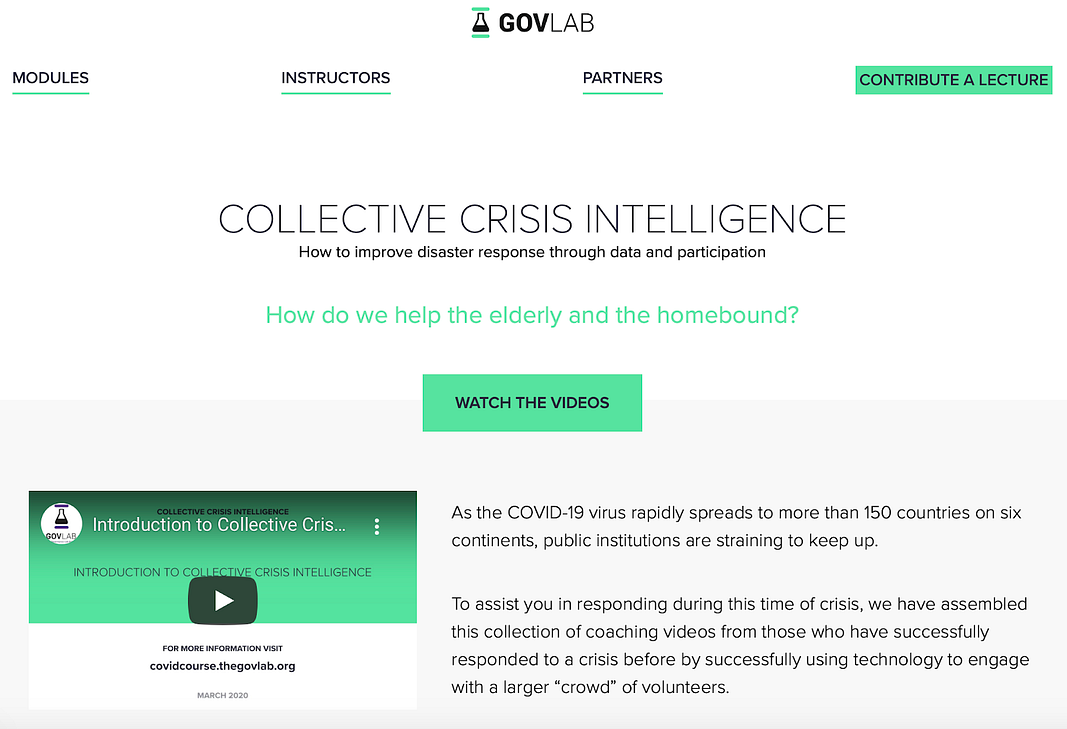It’s been a little over three weeks since COVID-19 was declared a pandemic. In that time, we’ve seen more than 300 maps created on the Ushahidi platform. An excellent demonstration of the power of collective intelligence, we’ve seen communities turn to crowdsourcing platforms like ours, self organising to provide mutual aid, document COVID-19 testing experiences, and create visibility on where to access essential resources.
A few weeks ago, Juliana and I co-created a module on crowdsourcing data, that is part of a larger effort by The Governance Lab (The GovLab) at the New York University Tandon School of Engineering’s massive open online course on “Collective Crisis Intelligence”, to help institutions improve disaster response through the use of data and volunteer participation.

The Collective Crisis Intelligence course is a collection of coaching videos from leading experts who have successfully responded to a crisis before. A joint effort involving eleven institutions, it aims to inform the response to the COVID-19 pandemic but can be applied to future disaster relief efforts. Each module provides powerful examples of how people have come together to use collective intelligence and collective action during times of crises.
In our module, we pose some key questions you should consider as you plan your crowdsourced response to COVID-19.
What informational gaps exist?
What information from the public would be helpful to you as you respond to the crisis? A helpful example around this would be how Government response teams globally have turned to self reporting platforms, to help them identify geographic distribution of people experiencing COVID-19 symptoms. The New Jersey State government has set up a call center to help them identify hotspots, and have this data inform where to set up testing centers. The SafeCast team in Japan are doing similar work by highlighting personal stories on people’s experiences while seeking testing, in hopes that it will help governments around the world set up testing centers.
How can members of the public help?
Responding to this crisis requires collective responsibility. Everyone in the world is being asked to play their part in flattening the curve. It’s therefore important that you think of ways to collaborate with the public to effectively respond. There’s plenty of examples we’ve seen in the past few weeks that illustrate this, e.g
- NZ Lockdown Open Services: Map of services providers open for business during NZ's lockdown
- Covid-19 Testing Lab Finder (India): Listing government approved testing labs for COVID-19 (coronavirus) in India.
You also need to think about the ways the public will consume this information, and that it is relevant to the place where they are.
Are there existing projects doing similar work?
“Alone you go faster, Together we go further” — African Proverb
Please do not reinvent the wheel. Collaborative efforts are often more effective than those done individually. You do not have to start from scratch. Check in with your local community to find out if there are other groups already working on a similar response, and offer your assistance. Jump into existing open source projects and improve on them. If there are no ongoing efforts, and you are the first, invite others to assist. Disjointed and duplicative efforts only add confusion to response activities, which can cost people lives.
What are the risks associated with crowdsourcing data? And how can you mitigate them?
The biggest concern with crowdsourcing revolves around verification. Can you trust in the veracity of information you’re receiving from the public? Can the authorities and other stakeholders trust the information shared on your platform? You’ll need to think about what processes to put in place to handle the deluge of data that will inevitably — whether automated, or those requiring human filters.
Personal identifying information, especially at a time like this where we’re seeing increased cases of discrimination, needs to be handled with extreme care. It’s important to protect people’s digital privacy rights. You need to develop a clear strategy on handling PII. Ask yourself, Do you really need to ask for an individual’s name? Or is a zip code or general location enough for the type of information you would like to gather from the public?
Closing out the feedback loop is extremely important. You need to communicate clearly and manage expectations of the public. Have you made any promises of response when someone submits a report? What is your capacity to act and respond and what time frame are you promising a response? If you feel that you do not have capacity, are there organisations you can work with to handle the response?
Who’s likely to benefit from this?
- The Public: They’ll be able to share their experiences with people who can respond and help them
- Responders: They will have clarity on what is needed, and how they can help
- Decision makers: They can get certain indicators to improve their response and allocate resources. The covid19 crisis is fluid, the situation one day differs from the next, crowdsourcing data can help answer the question “How are things on the ground today?”.
The full Collective Crisis Intelligence course is free, and can be accessed at https://covidcourse.thegovlab.org/.
If you have any questions, or would like to explore a partnership with Ushahidi to support your response, please feel free to get in touch.
You can also see more examples of projects using Ushahidi to respond to Covid-19 here.